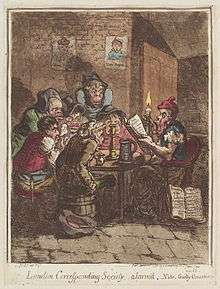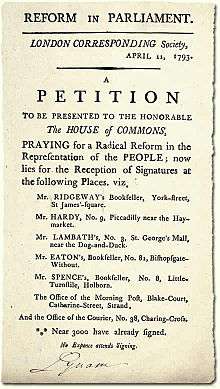London Corresponding Society
The London Corresponding Society (LCS) was a British Radical organisation, with a membership consisting primarily of artisans, tradesmen, and shopkeepers. At its peak, the society boasted roughly 3,000 dues-paying members who shared the goal of reforming the political system.[1] Formed in 1792 by Thomas Hardy, the society's key mission was to ensure universal suffrage for British men and annual parliaments. Due to the perceived French revolutionary influence on the society and its calls for radical political change, the government of William Pitt the Younger bitterly opposed it, accusing it on two occasions of plotting to assassinate the King, and putting its key leaders on trial in 1794 for treason. However, due to the transparent falsity of the government's claims, those leaders, including Hardy, John Thelwall, and John Horne Tooke, were all acquitted.[2] After exerting "undue influence" on the European political climate in the last decade of the 18th century, the LCS and other organisations like it were outlawed by a 1799 Parliamentary Act, and efforts to maintain an underground organisation were stymied by their outlaw status and financial troubles and mismanagement.[3]
| Formation | 25 January 1792 |
|---|---|
| Purpose | Radical parliamentary reform |
| Headquarters | London |
Key people | Thomas Hardy, Joseph Gerrald, Maurice Margarot, Edward Despard |


Early influences and foundation
The European Enlightenment, American independence, and later the French Revolution reinvigorated interest in the concepts of republicanism, popular sovereignty, and self-representation in late 18th century Britain, spurring the creation of various politically motivated organizations and societies, most prominently the Society for Constitutional Information (SCI). The pamphlets published by the SCI, the increasingly popular Rights of Man by political thinker Thomas Paine, and the abundance of other political tracts inspired a shoemaker, Thomas Hardy, to found the LCS on 25 January 1792,[4] as a society including "all descriptions and classes of men" to carry out a "radical reform of parliament."[5] Moreover, Hardy quickly realized that the general public needed to be educated on the subject of their political rights, and the LCS's secondary aim became to provide cheap, accessible publications and open meetings to the masses.[1] Hardy was quickly joined by founding members John Frost, Maurice Margarot and Joseph Gerrald. Other prominent members included John Baxter, Francis Place, Edward Marcus Despard, Olaudah Equiano and William Hone. The LCS also had branches in Manchester, Norwich, Sheffield, and Stockport,[6] Scotland, and Ireland. Irish rebels, such as Despard, became the early left wing of the London Corresponding Society.[7]
Organizational structure
From the beginning, the LCS was viewed with suspicion by the British government, and was infiltrated by spies on the government payroll. In addition to domestic subversion, the state authorities feared the entrance of foreign spies into Britain to such an extent that they created the Aliens Act of 1793 in order to screen all foreigners entering the country. When applying for admission, prospective immigrants were required to verify their names, ranks, occupations, and addresses.[8] Those who did not comply were arrested. To encourage discussion and a sense of community in such a context of mutual suspicion, and to thus discourage spying, the society was divided into 79 "divisions"[1] which were further divided into "tithings" of ten members who lived near each other throughout the London area. Each division met twice a week to conduct business and discuss historical and political texts.[9] In contrast to some of its contemporaries, the organization as a whole provided a sense of present action, allowing all citizens to participate in open debate, and providing democratic elections to elect members to leadership positions such as tithing-man, divisional secretary, sub-delegate, or delegate.[1]
Membership
Members were mostly small independent craftsmen, people whose jobs were secure even when their politics were unpopular, and who were thus less vulnerable to threats and intimidation. Three hundred and forty-seven listed members included:[10]
- forty-three shoemakers
- twenty-seven weavers
- twenty-four tailors
- nineteen in the watch trade (specifically, two watch case makers, a watch face painter, a watch spring maker, ten watchmakers, a clock case maker and four clock makers)
- two mathematical instrument makers
At the height of its popularity, the Society had over 3,500 members, each of whom paid a penny a week.[11] Many of the leading members were Deists, who opposed organized religion on the grounds that nature and reason provided the necessary and sufficient means to experience God.
Key activities, 1792–1795
The first prominent public action of the LCS was the 29 November 1792 publication of the pamphlet "Address of the London Corresponding Society to the other Societies of Great Britain, united for obtaining a Reform in Parliament", stating their aims while clarifying a position of non-violent reform through "moral force."[5] This was just one of a series of over 80 similar tracts calling for reform as the LCS gained followers and popularity.[12] By mid–1794, the LCS had gained enough traction to call for a convention of similar reform societies. In response, due to an inexplicable and unsubstantiated fear of a violent French Revolution-style rebellion, some leaders of the LCS, including Hardy, were arrested and charged with treason as part of the 1794 Treason Trials. Despite claims that the LCS was plotting to depose or assassinate the King and members of Parliament, the government's arguments were so unsubstantiated that juries acquitted LCS organizers Hardy, John Thelwall, and John Horne Tooke.[3] The LCS's popularity only continued to grow until the government, increasingly uneasy, passed the Treason Act and Seditious Meetings Act in 1795, which, while short of outright banning reform societies, made it increasingly difficult to conduct large meetings.[1] While the LCS continued to publish works and function in some capacity for the next three years, the effect of these acts was destabilizing and the society gradually lost traction and fell apart due to disorganization and the radicalization of some of its members. A final Parliamentary Act of 1799 "for the more effectual suppression of societies established for seditious and treasonable Purposes; and for better preventing treasonable and seditious practices", which referenced the LCS by name (among others), banned reform societies altogether, disbanding the LCS as an entity for all intents and purposes.[13]
Government response
Due to the ongoing French Revolution and subsequent exodus of French émigrés to Britain, the administration of William Pitt the Younger feared a "Jacobin uprising" aimed to overthrow Parliament and the King, and the widespread reach of the LCS and its pamphlets threatened a populist insurrection similar to what had been seen in France. What was most troubling about the LCS and societies like it were that they carefully operated within the law, meaning there was no legitimate reason for government interference in their activities. This tense climate resulted in infiltration of the LCS and other societies by government spies. These spies encouraged more radical societies to engage in potentially seditious activities, allowing the administration to paint them all as insurrectionists. As a result, the government was able to prosecute LCS members both for sedition and for their involvement with other societies potentially engaged in illegal activities. Ultimately, however, the LCS's popularity forced the government to rely on legislation to prevent the spread of the reform movement.[14]
Legacy
The LCS influenced the reform movements of the early 19th century, particularly Chartism, which in turn contributed to the 19th century Reform Bills. The 1832 Reform Act in particular contained many of the reforms called for by the LCS.[3]
References
- Hunt, Jocelyn B. Understanding the London Corresponding Society a Balancing Act between Adversaries Thomas Paine and Edmund Burke. Thesis. University of Waterloo, 2013. pp. 1-13
- I. R. Christie, Stress and Stability in Late Eighteenth-Century Britain. Reflections on the British Avoidance of Revolution (Oxford: Clarendon Press, 1986), pp. 50–51.
- Weinstein, Benjamin (1 April 2002). "Popular Constitutionalism and the London Corresponding Society". Albion: A Quarterly Journal Concerned with British Studies. 34 (1): 37–57. doi:10.2307/4053440. JSTOR 4053440.
- Vandehey, Reed Joseph (28 February 1975). Parliament and the London Corresponding Society (PDF) (doctoral). Portland State University. p. 8.
- Thale, Mary; Society, London Corresponding (4 August 1983). Selections from the Papers of the London Corresponding Society 1792-1799. Cambridge University Press. pp. 5–8. ISBN 9780521243636.
- Arnold-Bake, Charles (1996) The Companion to British History (2nd ed.) Routledge, London, pp. 364-365 ISBN 0-415-26016-7
- Smith, A.W (1995). "Irish Rebels and English Radicals 1798-1820. Past & Present". JSTOR 650175. Cite journal requires
|journal=(help) - "The 1905 Aliens Act | History Today". www.historytoday.com. Retrieved 18 December 2015.
- Barrell, John (5 June 2003). "Divided We Grow". London Review of Books. pp. 8–11. ISSN 0260-9592. Retrieved 12 December 2015.
- Selections From The Papers Of The London Corresponding Society, Cambridge University Press 1983, page xix ISBN 9780521089876
- Iain Hampsher-Monk, The Impact of the French Revolution: Texts from Britain in the 1790s. Cambridge University Press, 2005, p. 263.
- "Address of the London Corresponding Society… for obtaining a Reform in Parliament". The British Library. Retrieved 12 December 2015.
- An act for the more effectual suppression of societies established for seditious and treasonable purposes, and for better preventing treasonable and seditious practices: 12th July 1799. G.E. Eyre and W. Spottiswoode. 1 January 1847.
- "Parliamentary Reform." Times [London, England] 26 November 1831: 2. The Times Digital Archive. Web. 12 December 2015.